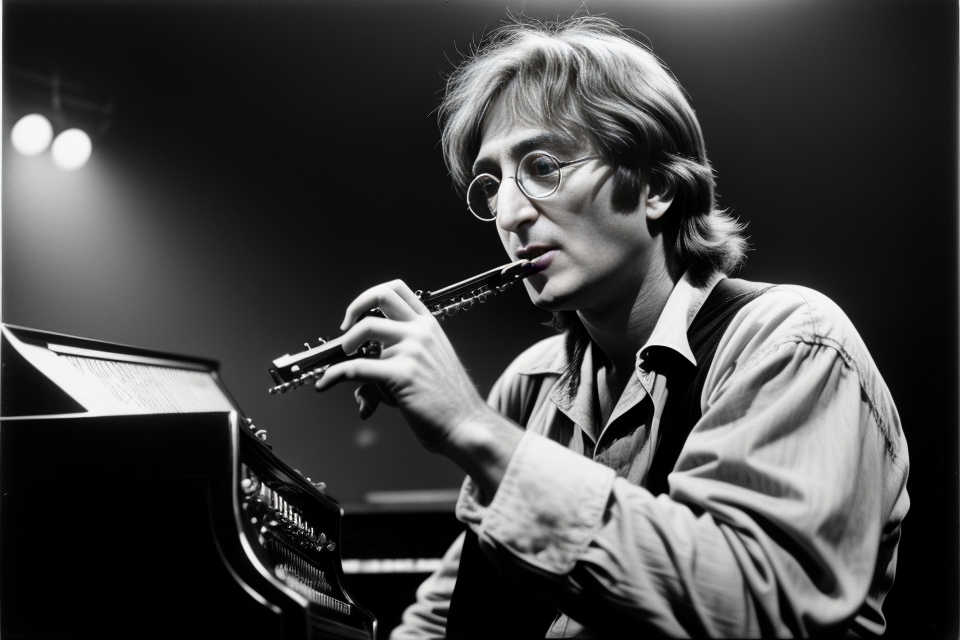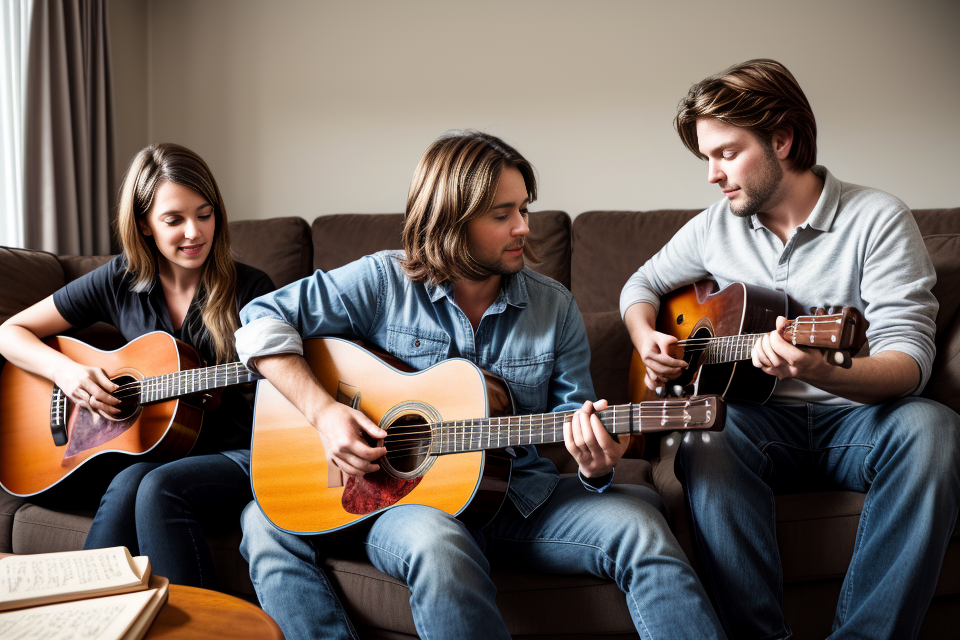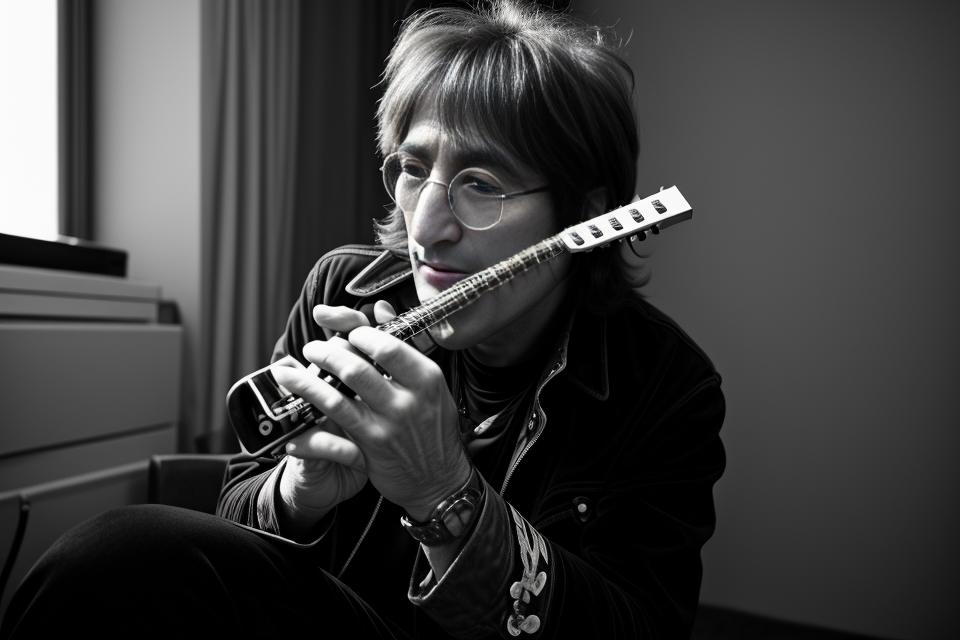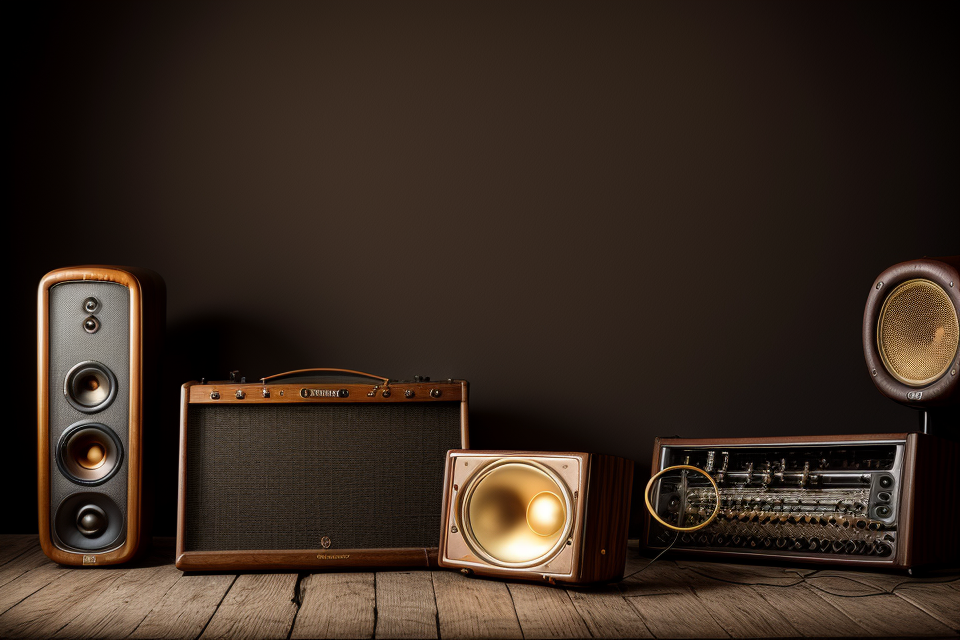John Lennon, the legendary musician and founding member of The Beatles, was known for his distinctive sound and style. One of the instruments that he was particularly fond of was the harmonica. Lennon’s harmonica playing was an integral part of The Beatles’ music, adding a raw, bluesy edge to many of their classic songs. But what kind of harmonica did Lennon play? In this article, we’ll explore the different types of harmonicas that Lennon used throughout his career, and how his playing influenced the use of the instrument in popular music. Whether you’re a harmonica player or simply a fan of The Beatles, read on to discover the story behind Lennon’s signature sound.
John Lennon, the legendary musician and one of the founding members of The Beatles, was known to play a variety of harmonicas. However, it is said that his preferred harmonica was the C major diatonic harmonica in the key of C. This particular harmonica is a popular choice among many musicians and is well-suited for playing blues and rock music. Lennon’s use of the harmonica was a prominent aspect of The Beatles’ sound and has had a lasting impact on the world of music.
A Brief History of the Harmonica
The Origins of the Harmonica
Who Invented the Harmonica?
The harmonica was invented by a German immigrant named Christian Friedrich Ludwig Buschmann in the early 19th century. Buschmann was a musician and instrument maker who patented the first harmonica in 1821. The harmonica was initially called the “Mundharmonika,” which translates to “mouth harmonica” in English.
The Harmonica’s Early Years
The harmonica quickly gained popularity in Europe and America, especially among working-class musicians who appreciated its portability and affordability. The instrument was initially used primarily in folk and blues music, but it eventually made its way into other genres as well. The harmonica’s simple design and versatility have made it a staple of popular music for over two centuries.
The Harmonica’s Evolution
How the Harmonica Evolved Over Time
The harmonica is a small, portable instrument that has been around for over a century. It was invented in the late 1800s by a German musician named Christian Bernhard Fischotte. Initially, the harmonica was not very popular, but over time, it gained popularity and became a staple in many genres of music.
One of the main reasons for the harmonica’s popularity is its portability. It is small and lightweight, making it easy to carry around and play anywhere. Additionally, the harmonica is relatively inexpensive, making it accessible to musicians of all skill levels and income levels.
Another reason for the harmonica’s popularity is its versatility. It can be played in a variety of ways, from simple melodies to complex harmonies. This versatility has made it a popular choice for many different types of music, including blues, rock, country, and folk.
Key Innovations in Harmonica Design
Over the years, there have been many innovations in harmonica design. One of the most significant innovations was the development of the “mouth organ,” which is a type of harmonica that is played by holding it in the mouth and blowing or sucking air through it. This type of harmonica was first introduced in the late 1800s and quickly became popular among musicians.
Another significant innovation in harmonica design was the development of the “diatonic” harmonica. This type of harmonica is designed to play in a specific key and has a set of reeds that are tuned to that key. Diatonic harmonicas are widely used today and are a popular choice among musicians because of their versatility and ease of use.
Overall, the harmonica has come a long way since its invention in the late 1800s. From its humble beginnings as a small, portable instrument to its current status as a staple in many genres of music, the harmonica has proven to be a versatile and enduring instrument.
The Importance of the Harmonica in Music
The Harmonica’s Role in Different Genres
Blues and Folk Music
The harmonica has been an essential instrument in blues and folk music since the early 20th century. Its unique sound and portability make it perfect for musicians who want to express their emotions through music. Blues and folk musicians often use the harmonica to create a melancholic or nostalgic atmosphere, which is a crucial element of these genres. The harmonica’s versatility also allows musicians to experiment with different playing techniques, such as bending and vibrato, to create unique sounds and expressions.
Rock and Roll
The harmonica also plays a significant role in rock and roll music. It was popularized by musicians such as John Lennon, who used it to create a raw and energetic sound. In rock and roll, the harmonica is often used to add a gritty, edgy tone to the music. It is also used to create call-and-response patterns with other instruments, such as the guitar or drums, which is a key element of rock and roll music. The harmonica’s portability and ease of use make it an ideal instrument for musicians who want to create a lively and energetic sound without the need for expensive equipment.
Famous Harmonica Players
Little Walter
Little Walter was an American blues musician who is widely regarded as one of the most influential harmonica players of all time. He was known for his unique style of playing, which featured fast and intricate patterns that were revolutionary for the time. His innovative approach to the harmonica influenced countless musicians, including John Lennon, who cited Little Walter as a major influence on his own playing.
Sonny Boy Williamson
Sonny Boy Williamson was another highly influential harmonica player who was active in the 1940s and 1950s. He was known for his soulful and expressive playing style, which incorporated a wide range of notes and bends. Williamson’s playing was characterized by its emotional intensity and ability to convey a sense of deep feeling in his music. Like Little Walter, he was also a major influence on John Lennon, who admired his ability to make the harmonica sound like a full orchestra.
John Lennon and the Harmonica
How John Lennon Discovered the Harmonica
John Lennon discovered the harmonica when he was a teenager. He was listening to the music of Sonny Boy Williamson, a popular harmonica player, and was intrigued by the sound of the instrument. Lennon soon after began to experiment with the harmonica himself, learning how to play basic blues and rock and roll riffs.
John Lennon’s Favorite Harmonica Key
John Lennon’s favorite harmonica key was the A minor key. He often used a specific harmonica, a Hohner Marine Band, in this key. The A minor key provided a distinct and melancholic sound that suited many of the songs he wrote for The Beatles.
The Types of Harmonicas John Lennon Played
Throughout his career, John Lennon played various types of harmonicas, including the diatonic and chromatic harmonicas. He mostly used diatonic harmonicas, which are designed to play in a specific key and its related chords. Lennon preferred the blues and rock and roll styles, which were well-suited to the sound of the diatonic harmonica. He also experimented with chromatic harmonicas, which allow for more complex and nuanced playing, but he didn’t use them as frequently as the diatonic harmonicas.
The Marine Band Harmonica
About the Marine Band Harmonica
The Marine Band Harmonica is a type of diatonic harmonica that was first introduced in the late 19th century by the Hohner company. It is known for its distinctive sound and has been a popular choice among musicians of various genres. The Marine Band Harmonica is characterized by its simple design, durability, and affordability, making it an accessible instrument for both beginners and professionals.
John Lennon’s Connection to the Marine Band Harmonica
John Lennon, a prominent figure in the British Invasion and a member of the Beatles, was known for his proficiency in playing the harmonica. He famously used the Marine Band Harmonica, specifically the key of A, in many of the band’s songs, including “Love Me Do” and “Please Please Me.” Lennon’s use of the Marine Band Harmonica helped to popularize the instrument and solidify its place in rock music.
The Special 20 Harmonica
About the Special 20 Harmonica
The Special 20 Harmonica is a type of diatonic harmonica that was introduced by the Hohner company in the 1950s. It features 10 holes and a range of 2 octaves, making it a versatile and popular choice among musicians. The Special 20 Harmonica is known for its rich, full sound and its ability to produce a wide range of tones and notes.
John Lennon’s Use of the Special 20 Harmonica
John Lennon was a prominent user of the Special 20 Harmonica, incorporating it into many of The Beatles’ songs. Lennon was particularly drawn to the instrument’s ability to produce a raw, gritty sound, which he often used to create a sense of tension and emotion in his music. He was also known for experimenting with different playing techniques, such as bending and overblowing, to create unique and expressive sounds.
The Special 20 Harmonica was a staple of Lennon’s songwriting and performance style, and his use of the instrument had a significant impact on the popularity of the harmonica in rock music. Lennon’s influence on the harmonica can still be heard in the music of contemporary artists, who continue to draw inspiration from his innovative use of the instrument.
Other Harmonicas Played by John Lennon
The Big Ben Harmonica
About the Big Ben Harmonica
The Big Ben Harmonica is a type of diatonic harmonica that is designed with a traditional bluesy sound in mind. It is also known as the “Major/Minor” harmonica due to its ability to play both major and minor keys. This harmonica is a popular choice among musicians for its versatility and the range of sounds it can produce.
John Lennon’s Use of the Big Ben Harmonica
John Lennon was known to have played the Big Ben Harmonica extensively throughout his career, particularly during the early years of The Beatles. He often used it to add a bluesy and soulful sound to many of their songs, such as “Love Me Do” and “I Want to Hold Your Hand”.
In addition to its use in The Beatles’ music, John Lennon also featured the Big Ben Harmonica in several of his solo projects, including the song “Jealous Guy” from his album “Imagine”.
Overall, the Big Ben Harmonica was a staple instrument in John Lennon’s music, and his use of it helped to shape the sound of popular music in the 1960s and beyond.
The Mouth Organ
About the Mouth Organ
The mouth organ, also known as the harmonica, is a small, portable, and inexpensive instrument that can be played by holding it in the hands and blowing or drawing air through it. It has a single or multiple reeds that vibrate to produce sound. The mouth organ has a rich, expressive sound and is capable of playing a wide range of musical styles, from blues and jazz to rock and pop.
John Lennon’s Use of the Mouth Organ
John Lennon was a well-known user of the mouth organ, incorporating it into many of The Beatles’ songs. He was particularly drawn to the instrument’s expressiveness and its ability to create a raw, primal sound. Lennon’s use of the mouth organ can be heard in many of The Beatles’ early recordings, including “Love Me Do” and “P.S. I Love You.”
Lennon was also known for experimenting with different types of mouth organs, using a variety of brands and models to achieve the sounds he wanted. He was particularly fond of the harmonica’s ability to create bends and other expressive effects, which he used to great effect in his playing.
Overall, John Lennon’s use of the mouth organ was a key element of The Beatles’ sound, and his influence on the instrument’s popularity and development cannot be overstated.
How to Play Harmonica Like John Lennon
Holding the Harmonica
The Correct Grip for Playing the Harmonica
Proper grip is crucial for producing clear and consistent notes while playing the harmonica. To hold the harmonica like John Lennon, follow these steps:
- Place the harmonica firmly between your thumb and index finger, ensuring that the harmonica is positioned with the logo facing you.
- Hold the harmonica upright, with the mouthpiece pointing towards the ceiling.
- Keep your wrist steady and avoid any excessive movement while playing.
The Importance of Posture and Breathing
Apart from the correct grip, maintaining the right posture and breathing technique is essential for playing the harmonica like John Lennon. Here are some tips:
- Sit or stand up straight, with your shoulders relaxed and your spine aligned.
- Take a deep breath before playing each note, filling your lungs completely and exhaling slowly.
- Inhale through your nose and exhale through your mouth while playing the harmonica.
- Use your diaphragm while breathing to produce a richer and fuller sound.
By focusing on the correct grip, posture, and breathing techniques, you can play the harmonica like John Lennon and develop a smooth and powerful sound.
Basic Harmonica Techniques
Bending Notes
Bending notes is a technique that involves changing the pitch of a note while playing it. This can be done by holding the harmonica in your mouth and using your tongue to press down on the reed plates, bending them slightly to raise the pitch of the note. This technique is commonly used in blues and rock music and is a signature element of John Lennon’s harmonica playing.
To bend notes on a harmonica, start by holding the harmonica with the mouthpiece pointing upwards and the reed plates facing towards you. Use your tongue to press down on the reed plates and bend the notes as needed. It’s important to experiment with different levels of pressure and movement to achieve the desired pitch.
Overblowing
Overblowing is a technique that involves blowing air into the harmonica to produce a higher pitch than the one played by the reed plates. This is achieved by blowing air into the harmonica without covering any holes, causing the reed plates to vibrate at a higher frequency and produce a higher pitch.
To overblow on a harmonica, start by holding the harmonica with the mouthpiece pointing upwards and the reed plates facing towards you. Blow air into the harmonica without covering any holes, and experiment with different levels of air pressure to achieve the desired pitch.
Vamping
Vamping is a technique that involves playing a repeated rhythm or pattern on the harmonica. This can be done by holding down the valve of the harmonica with your thumb and using your index finger to cover and uncover the holes to produce different notes.
To vamp on a harmonica, start by holding the harmonica with the mouthpiece pointing upwards and the reed plates facing towards you. Use your thumb to hold down the valve and your index finger to cover and uncover the holes, creating a repeating rhythm or pattern. Experiment with different patterns and rhythms to create your own unique vamping style.
John Lennon’s Signature Riffs and Licks
John Lennon was known for his distinctive harmonica playing style, which included many signature riffs and licks that helped to define the sound of The Beatles. To play harmonica like John Lennon, it’s important to understand and replicate these signature elements in your own playing. Here are some examples of how to play two of Lennon’s most famous songs on harmonica:
How to Play “Love Me Do” on Harmonica
- Hold the harmonica in your mouth, with the microphone pointing towards your mouth
- Bend the second note of each draw to create a “bend” effect
- Play the riff in the key of G major (the song’s original key)
- Use a C harmonica in second position to play the riff
How to Play “I Want to Hold Your Hand” on Harmonica
- Bend the third note of each draw to create a “bend” effect
- Play the riff in the key of E major (the song’s original key)
- Use an A harmonica in second position to play the riff
In addition to these specific songs, there are many other examples of John Lennon’s signature riffs and licks that can be found throughout The Beatles’ discography. By studying these examples and practicing them on your own harmonica, you can develop a style that is reminiscent of John Lennon’s unique playing style.
Tips for Improving Your Harmonica Skills
Practice, Practice, Practice
Practice is key to improving your harmonica skills. Start by learning the basics of playing simple melodies and then gradually move on to more complex tunes. It’s important to be patient with yourself and to practice regularly.
Listen to John Lennon’s Harmonica Playing
Listening to John Lennon’s harmonica playing can provide inspiration and insight into his techniques. Pay attention to the way he uses different harmonica types and techniques to create his unique sound. You can also learn from other harmonica players who have mastered the instrument.
Experiment with Different Harmonica Types and Techniques
Experimenting with different harmonica types and techniques can help you find your own style and sound. Try playing with different brands, sizes, and keys of harmonica to see which ones work best for you. Additionally, experiment with different playing techniques such as bending, tremolo, and vibrato to add more variety to your playing. Remember to have fun and be creative while exploring the possibilities of the harmonica.
FAQs
1. What kind of harmonica did John Lennon play?
John Lennon played a variety of harmonicas, but he was most commonly associated with the diatonic harmonica in the key of A. This type of harmonica is also known as a “blues harp” and is commonly used in blues and rock music.
2. Why did John Lennon choose to play the diatonic harmonica in the key of A?
John Lennon preferred the diatonic harmonica in the key of A because it was well-suited for the type of music he played, including rock and roll and rhythm and blues. The A-note is a common note in many songs and the A-harmonica was a versatile choice that allowed him to play in a variety of keys.
3. Did John Lennon use any other types of harmonicas?
Yes, John Lennon also played the chromatic harmonica, which is a more complex instrument that allows for greater tonal range and precision. He used the chromatic harmonica in some of his later recordings, such as “Mind Games” and “Double Fantasy”.
4. How did John Lennon learn to play the harmonica?
John Lennon taught himself to play the harmonica by listening to blues and rock and roll records and experimenting with different techniques. He was inspired by the harmonica playing of musicians such as Sonny Boy Williamson and Little Walter, and he worked to develop his own unique style.
5. Did John Lennon use any special techniques when playing the harmonica?
Yes, John Lennon was known for his use of bending and overblowing techniques, which allowed him to create a wide range of sounds and effects on the harmonica. He also used techniques such as vibrato and tremolo to add expressiveness to his playing.
6. Can I learn to play the harmonica like John Lennon?
Yes, you can learn to play the harmonica like John Lennon by practicing the techniques he used and studying his recordings. There are many resources available online and in-person to help you learn to play the harmonica, including instructional videos, books, and classes.



